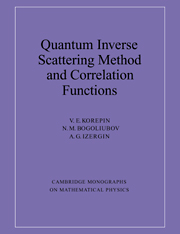Book contents
- Frontmatter
- Contents
- Preface
- Part I The Coordinate Bethe Ansatz
- Part II The Quantum Inverse Scattering Method
- Part III The Determinant Representation for Quantum Correlation Functions
- Part IV Differential Equations for Quantum Correlation Functions
- Introduction to Part IV
- XIII Correlation Functions for Impenetrable Bosons. The Determinant Representation
- XIV Differential Equations for Correlation Functions
- XV The Matrix Riemann-Hilbert Problem for Correlation Functions
- XVI Asymptotics of Temperature-dependent Correlation Functions for the Impenetrable Bose Gas
- XVII The Algebraic Bethe Ansatz and Asymptotics of Correlation Functions
- XVIII Asymptotics of Correlation Functions and the Conformal Approach
- Final Conclusion
- References
- Index
XVII - The Algebraic Bethe Ansatz and Asymptotics of Correlation Functions
Published online by Cambridge University Press: 04 August 2010
- Frontmatter
- Contents
- Preface
- Part I The Coordinate Bethe Ansatz
- Part II The Quantum Inverse Scattering Method
- Part III The Determinant Representation for Quantum Correlation Functions
- Part IV Differential Equations for Quantum Correlation Functions
- Introduction to Part IV
- XIII Correlation Functions for Impenetrable Bosons. The Determinant Representation
- XIV Differential Equations for Correlation Functions
- XV The Matrix Riemann-Hilbert Problem for Correlation Functions
- XVI Asymptotics of Temperature-dependent Correlation Functions for the Impenetrable Bose Gas
- XVII The Algebraic Bethe Ansatz and Asymptotics of Correlation Functions
- XVIII Asymptotics of Correlation Functions and the Conformal Approach
- Final Conclusion
- References
- Index
Summary
Introduction
In the previous chapter we evaluated the asymptotics of the field correlation function using differential equations. In this chapter we present a completely different approach. Instead of determinant representations we shall write some special series (which emphasize the role of the R-matrix). This series is especially efficient for the current (j(x) = Ψ†(x)Ψ(x)) correlation function. It helps us to evaluate the asymptotics at zero temperature. The asymptotics of temperature correlation functions also can be obtained at any value of coupling constant for the Bose gas. The series for the correlation function
is based on the classification of all exactly solvable models (section VII.6) related to the fixed R-matrix. The series explicitly separates the contribution of the R-matrix and of the arbitrary functions a(λ) and d(λ). The Fourier coefficients of the irreducible part depend only on the R-matrix. Let us emphasize once more that in this chapter we shall consider the penetrable Bose gas (0 < c < ∞).
In section 1 the algebraic foundation of the new approach to correlation functions is given. In section 2 the series representation for the current correlator 〈j(x)j(0)〉 at zero temperature (in the thermodynamic limit) is given. In section 3 temperature correlations (for the penetrable Bose gas, 0 < c < ∞) are constructed. In section 4 explicit formulæe for asymptotics are presented. In section 5 the emptiness formation probability (the probability of absence of particles in some space interval due to thermal fluctuations) is evaluated.
- Type
- Chapter
- Information
- Quantum Inverse Scattering Method and Correlation Functions , pp. 483 - 501Publisher: Cambridge University PressPrint publication year: 1993

